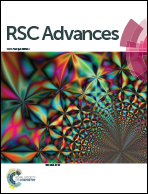A near-infrared “on–off” fluorescent and colourimetric cyanide chemodosimeter based on phenothiazine with applications in living cell imaging†
Abstract
A great deal of effort has been devoted to developing easy-to-use near-infrared probes for detecting analytes due to their advantages in the field of biosensing. Herein, a near-infrared “on–off” fluorescent chemodosimeter PTZ based on dicyano-vinyl-functionalised phenothiazine was designed and synthesised. The PTZ compound was shown to efficiently recognise cyanide ions in aqueous media by virtue of the special nucleophilicity of cyanide ions, which affects the intramolecular charge transfer efficiency in the molecule. Furthermore, it was found that it exhibited a rapid colourimetric and quenchable near-infrared (NIR) fluorescent response to cyanide ions with a detection limit as low as 67 nM, and that other anions showed almost no interference even at high concentrations. Optical spectroscopic measurements, 1H NMR and mass spectrometry titrations, and theoretical simulations were carried out to elucidate the sensing mechanism of compound PTZ. Moreover, potential applications of this compound for biosensing have been exemplified by the successful fluorescent microscopic imaging for the detection of cyanide ions in HeLa cells.


 Please wait while we load your content...
Please wait while we load your content...